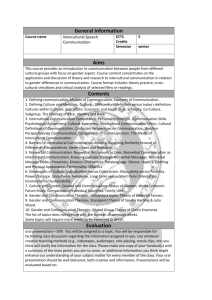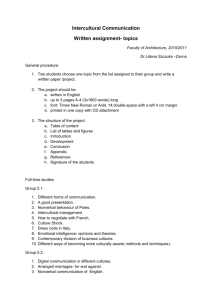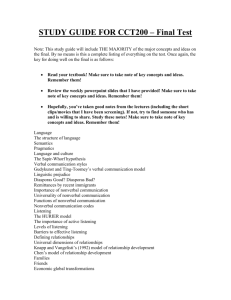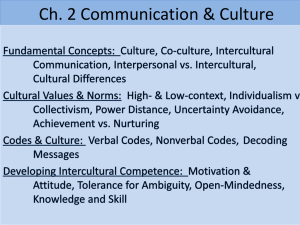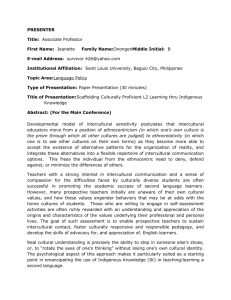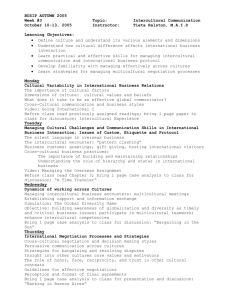Written assignment
advertisement
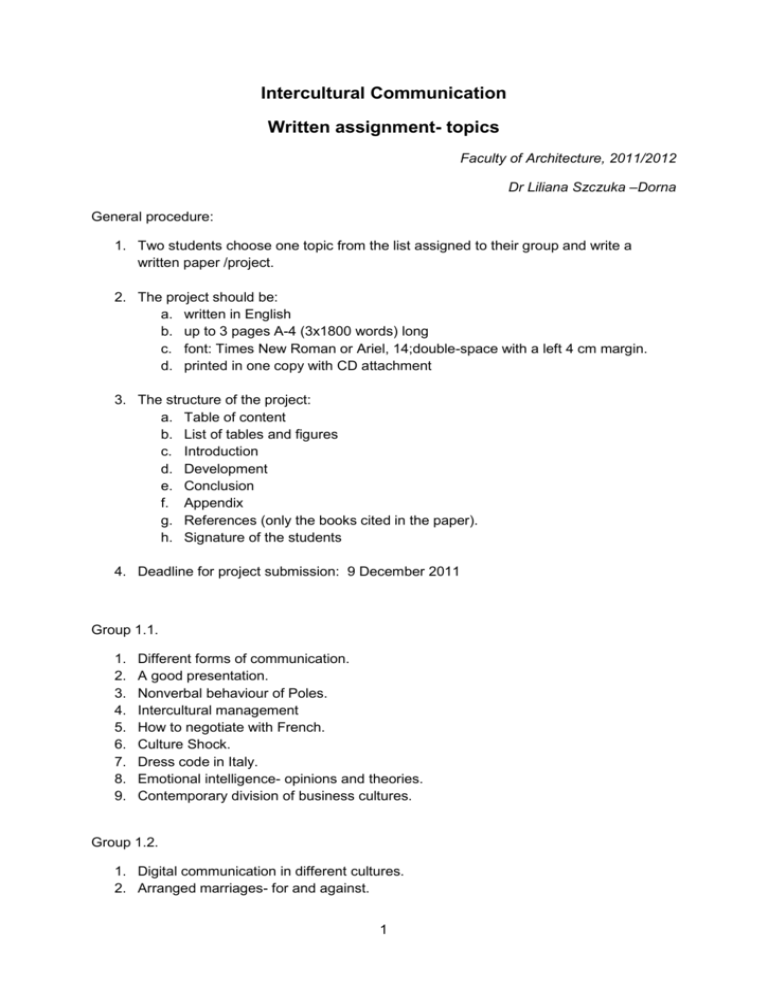
Intercultural Communication Written assignment- topics Faculty of Architecture, 2011/2012 Dr Liliana Szczuka –Dorna General procedure: 1. Two students choose one topic from the list assigned to their group and write a written paper /project. 2. The project should be: a. written in English b. up to 3 pages A-4 (3x1800 words) long c. font: Times New Roman or Ariel, 14;double-space with a left 4 cm margin. d. printed in one copy with CD attachment 3. The structure of the project: a. Table of content b. List of tables and figures c. Introduction d. Development e. Conclusion f. Appendix g. References (only the books cited in the paper). h. Signature of the students 4. Deadline for project submission: 9 December 2011 Group 1.1. 1. 2. 3. 4. 5. 6. 7. 8. 9. Different forms of communication. A good presentation. Nonverbal behaviour of Poles. Intercultural management How to negotiate with French. Culture Shock. Dress code in Italy. Emotional intelligence- opinions and theories. Contemporary division of business cultures. Group 1.2. 1. Digital communication in different cultures. 2. Arranged marriages- for and against. 1 3. 4. 5. 6. 7. 8. Nonverbal communication of English. How to negotiate with Germans. Dress code in China. How to solve intercultural conflicts. How to organize brunch and gala dinner. How to write a good report. Group 1.3. 1. 2. 3. 4. 5. 6. 7. Nonverbal communication of Spanish. Exchanging business cards in different cultures. Different forms of business small talk. English as lingua franca. American management practices. Kisses and hugs in formal meetings in different cultures. How to improve writing skills. Group 1.4. 1. 2. 3. 4. 5. 6. 7. 8. How to organize wine reception and lunch. How to improve speaking skills. Nonverbal behavior of Scandinavians. Stereotypes and their role in communication. How to negotiate with Russians. French management practices. Dress code in Poland and Japan- differences and similarities. Tony Brian- theories for contemporary managers. Group 1.5. 1. 2. 3. 4. 5. 6. 7. 8. Nonverbal behavior of Mexicans. Dress code in America. Ice-breakers: how to start a meeting with strangers. Physical appearance: creating good impression during meetings. Individualism and collectivism. Politeness in Poland and Japan- comparison. Do’s and taboos of Polish culture. Power distance in different cultures. Group 1.6. 1. 2. 3. 4. 5. Nonverbal behavior of Egyptians. Proxemics in different cultures. Benefits of intercultural communication. Three approaches to leadership. Japanese housing. 2 6. Intercultural Communication Competence. 7. Do’s and taboos of American culture. 8. Empathy and similarity in two selected cultures. Group 1.7 1. 2. 3. 4. 5. 6. 7. Dress code in Bulgaria. Business etiquette. How to improve listening skills. Bribes- to give or not to give. Geert Hofstede- division of cultures. Norwegian management practices. The meaning of silence in business meetings. Group 1.8 1. 2. 3. 4. 5. 6. 7. 8. Presents during official meetings. Dress code in Greece. E. Hall and his division of cultures. Definitions of nonverbal communication. How to negotiate with Arabs. How to improve negotiating skills. Gender stereotypes in two selected cultures. Giving a talk- important elements of public speaking. Group 1.9 1. Different ways of becoming more culturally aware( methods and techniques). 2. Describe one business culture and its representatives you have worked/ studied. Give advantages and disadvantages comparing to Polish culture. 3. R. Covey-his theory *8 habits of effective life. 4. Does bilingual children mean bilingual culture? 5. Globalization and mixture of cultures- what to understand and know in order to function in contemporary professional world. 6. Dress code in India. 7. Do we need Power Point presentations? Why or why not. 8. Code of ethics in contemporary business- examples. Group 1.10 1. 2. 3. 4. 5. 6. 7. 1. Gestures- for and against their use in business. Presents in the business world- for and against. Building effective Time Management Skills. Doing business in Netherlands. Intercultural organizations- examples and best practice. Abraham Maslow (1908-1970) and his theory about hierarchy of needs. Sex and gender roles in Japan and Saudi Arabia. 3 8. Intercultural Communication on the web pages- a resource file. Group 1.11 1. 2. 3. 4. 5. 6. 7. 8. 9. Motivation- its basic historical perspectives, nature and importance. Business correspondence- different forms. Nonverbal behavior of Canadian. Nonverbal communication at university. Describe the role and importance of communication in the managers’ job. Culture shock in Poland- how to help foreigners in our country. G. Hofstede and his index of cultures. Describe one business culture. Barriers to effective communication. Management skills- how to acquire them and what to do in order to upgrade knowledge. Group 1.12 1. Different forms of leaders. 2. How to become a successful architect? 3. Written English- which forms of business correspondence are the most important in use. Describe their forms and give examples. 4. How to develop intercultural awareness. 5. Describe one foreign culture. 6. Formal and informal communication in organizations. 7. Why people join groups and teams. 8. Ethical leadership. 9. Resolving and eliminating conflict. Grupa Angielska 1. Different cultures- description of models. 2. Engineering ethics- theory and practice. 3. Management challenges in a global economy: planning, decision making and leading. 4. Advisory Boards and Management Consultants- why we need them. 5. Cross Cultural Leadership. 6. Arguments for and against social responsibility. 7. Effective communication in a company. 8. What are the similarities and differences of oral and written communication? 9. Describe the individual and organizational barriers to effective communication. 10. Explain the differences between line and staff positions. What are the advantages and disadvantages of high versus low administrative intensity? 11. Compare teaching, training and development, noting any similarities and differences. 4 5

